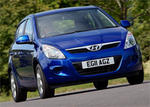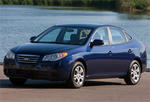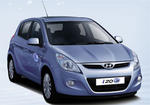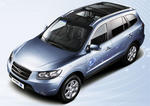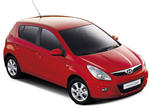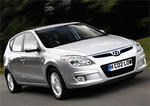
The Hyundai Blue Will concept has been unveiled today at the Seoul Motor Show in South Korea. The Hyundai Blue Will, codenamed HND-4, is the 4th concept to be developed by the Namyang Design Center. The hybrid system of the Hyundai Blue Will includes an aluminum 113 kW Petrol Direct Injected 1.6-liter engine and a 100 kw electric motor. The Hyundai Blue Will features a Continuously Variable Transmission and a Lithium Ion Polymer battery to store electricity for the motor.
The company says the Hyundai Blue Will will offer between 4.3 liter and 4.7 liters per 100 km fuel economy and will have a range of around 1050 km.
The Hyundai Blue Will also features three auxiliary power sources which include an Exhaust manifold-mounted Thermo-Electric Generator, Roof-mounted Dye-Sensitized Solar Cells and Regenerative Braking.
Hyundai Press Release:
Hyundai Motor Company today unveiled its first Plug-in HEV concept car at the Seoul Motor Show in South Korea. Named 'Blue-Will' by its creators at the Advanced Design Studio, the futuristic car targets 30 to 40 something single urbanites and young families with its highly unique character lines and detailed forms.


Promising an electric-only driving distance of up to 64km on a single charge and a fuel economy rating of up to 2.2 litres/100 km, Blue-Will is a test bed of new ideas that range from the unique profile to drive-by-wire steering and touch screen controls.
Blue-Will, codenamed HND-4, is the fourth in a series of highly innovative concept vehicles to come out of the Namyang Design Center.
Exterior
"Eco-sleeker" was the core concept driving the
design process. Its sweeping character lines and detailed form elevate this next generation hybrid to an entirely new level. Blue-Will's sleek surface treatment extends to the underbody where a full-length cover has been applied to minimize aerodynamic drag whilst maximizing fuel economy.
The LED panel on the front expresses a highly distinctive, futuristic image. The rear bike rack, neatly integrated into the trunk, adds an extra measure of convenience. To minimize weight, advanced materials such as carbon-fiber reinforced plastics and nano composites have been applied
to the side sills, moldings and fenders.
Recycled PET material was used for the headlamp bezel, while use has also been made of PLA and PA11 bio-plastics on interior and exterior parts.
Interior
Thanks to the rapid advances in information technologies, designers have had a completely free hand to redefine the interior space achieving a "digital flow" throughout the cabin space. The conventional gauge cluster has been replaced by an ultra-thin Transparent Organic Light Emitting Diode display mounted on the steering column which is adjustable for rake and distance. Thin-film TOLED technology allows
information to be displayed in full high resolution color.
The center stack is normally a very busy area in terms of the number of controls that must be packed into a small area but HND-4 designers have achieved a remarkably simple and clean look thanks to high-tech touch-screen control technology which extends operability to the HVAC, drive (PRNDL) selector and infotainment systems. The focal point is the Eco-Coach, a graphic display which helps promote fuel-saving driving habits by providing continuous feedback on fuel consumption and driving efficiency. Infotainment capabilities include Bluetooth-enabled speakers.
Hybrid Blue Drive Architecture
The Blue-Will concept is powered by an all-aluminum 113 kW Petrol Direct Injected 1.6L which is coupled to a Continuously Variable Transmission and a 100 kw electric motor which is at the heart of Hyundai's proprietary parallel hybrid drive architecture. Wheels are turned by power coming directly from the petrol engine, or the electric motor, or both together, as conditions demand. This parallel hybrid drive architecture serves as the foundation for future Hyundai hybrids, starting with the next-generation Sonata in the U.S.
For maximum luggage space, the fuel tank is under the rear seat where it is neatly bundled alongside the Lithium Ion Polymer battery which can be recharged using household electric current. Hyundai will be the first automaker in the world to apply Lithium Ion Polymer in a mass production vehicle this July when the Elantra LPI Hybrid Electric Vehicle goes on sale in Korea.
A further expression of Blue-Will's design flexibility is found on the panoramic roof where in a novel touch, the glass area integrates dye-sensitized solar cells without impeding visibility. The solar cells provide a trickle charge that helps operate a cabin cooling fan, reducing interior temperatures while the car is parked in the sun.
Thermal Generator: Energy Saving Innovation
Energy from hot exhaust gases is recaptured by a thermal generator which is fitted into the exhaust manifold. The thermal generator then converts the heat into electrical energy to help power auxiliary systems.
Efficiencies are further improved by the specification of low-rolling resistance tires and low-drag brakes where special attention has been paid to the engineering of the brake pads and callipers.
Blue-Will Specifications
Length
4,300 mm
Width
1,800 mm
Height
1,460 mm
Wheelbase
2,700 mm
Tires
245/40 R20 Low-Rolling Resistance
Engine
1.6L Gamma 113 kW GDI/ 100 kw Motor
Transmission
CVT/Fixed Gear
Batteries
Lithium Ion Polymer
Fuel Economy
(Pure HEV-Mode)
4.7L/100 km~4.3L/100 km
Fuel Economy
(Plug-in HEV Mode)
2.2L/100 km
Vehicle Range
1050 km
Steering
Drive-by-Wire
Gauge Cluster
Ultra-thin Transparent Organic LED
Drive Selector &
HVAC
Touch-Screen Control
Auxiliary
Power
Generation
1. Exhaust manifold-mounted Thermo-Electric Generator
2. Roof-mounted Dye-Sensitized Solar Cells
3. Regenerative Braking



